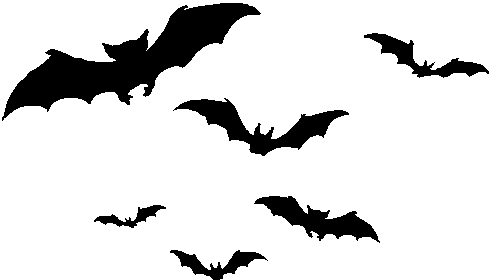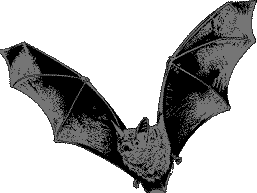
Gothic Gardening: Theme Gardens
Gardening for Bats (and other Gothic Organic Pest Controllers)
 Bats are important in
nature, and terribly gothic. If you want to increase
the bat population around your house, there are two basic things you can
do:
Bats are important in
nature, and terribly gothic. If you want to increase
the bat population around your house, there are two basic things you can
do:
- Grow plants which attract night-flying insects and
- Provide roosting areas for bats.
Bats can consume up to 500 insects an hour, including mosquitoes
(although I've read that mosquitoes make up only about 10% of their
diet). The health hazard to humans is small, since very few bats
actually carry rabies. Only ten people in thirty
years have gotten rabies from a bat bite. The main hazard comes from
bats roosting inside the house, which can be a source of
histoplasmosis. However, in the wild, bat populations are declining,
and natural roosting areas are being destroyed.
The Bat Garden
Burpee actually sells this as a "kit"
with all the seeds for several types of plants which attract the insects that
bats like to eat. Plants that should be in a bat garden include:- Salvia
- This has spikes of blooms in red, purple, salmon,
lilac, white, blue, and pink, so take your pick.
- Silene
- This plant has 3" clusters of deep rose flowers
- Phlox
- Star-shaped flowers and needle-like leaves. The flowers
can be blue, crimson, pink, white, and red.
- Stock
- This also has sturdy spikes of full, fragrant flowers
which come in pink, white, and lavender, and there's also the Evening
Stock from the night garden.
- Cornflower
- Also known as Bachelor's Buttons, these are
fragrant, many-petaled, old-fashioned flowers in pink, blue, white and
maroon.
- Spearmint
- A fragrant herb, which also has small white blooms.
Flowers that all bloom in the evening are Four o' Clocks, Moonflower, and
Nicotania.
The Bat Roost
You can build your own, or there are several sorts available for sale.- Bat House
- This houses about a dozen bats, and the single,
narrow, bottomless chamber is preferred by male bats, due to the
cooler temperature.
- Bat Condo
- This has four chambers, and appeals more to female
bats and their young who prefer a higher temperature environment. This
will house between 30 and 50 bats. It's also bottomless.
- Bat Mansion
- This mansion has 5 chambers, and an attic, which
will house up to 150 bats. Bats can move up and down inside the house
to the most comfortable temperature.
These three were sold by Pinetree Garden Seeds but I didn't see them in his year's catalog.
I've also seen plans for making bat houses. The important things to remember
are:
- use rough, seasoned lumber, and turn the rough sides inward
- grooves on the inside help bats to climb and roost
- hang the house 12-15 feet above ground in an area where it gets morning
sun, but is in shade during the afternoon, and is relatively protected from
the wind
- the house also needs to be placed about 20 feet from the nearest tree...this
is apparently to reduce their chances of getting hit by lightning
- place the bat house near a water source, or provide one nearby--and
make sure it's protected from cats
Bat Conservation International will
supply you with plans for a bat house.
Another option, if you live very southerly, is to leave a cabbage palm
unpruned, as this provides a nice roosting area.
Don't be discouraged if you don't attract bats right away....sometimes it
takes quite a bit of time before a bat population will establish itself in
an area, but once they do, they usually return. (The chances of a bat house
being occupied are increased if the house is hung by early April, and if
there are already bats roosting nearby.)

Bat Facts
 There are 950 species of bats. Two-thirds of these species are insect-eaters,
with most of the remaining third eating fruit, nectar, and pollen. A very
few species eat fish, or birds, small mammals, and reptiles, and three species
feed on blood.
There are 950 species of bats. Two-thirds of these species are insect-eaters,
with most of the remaining third eating fruit, nectar, and pollen. A very
few species eat fish, or birds, small mammals, and reptiles, and three species
feed on blood.
The largest bat, Pteropus vampyrus, has an average weight of 3
1/2 oz., and a wingspan of over 5 feet! The smallest bat,Craseonycteris thonglongyae, weighs less than a tenth of an
oz., and has a wingspan of six inches.
A bat can consume up to one-half its weight in insects in one night, and might
fly as far as 50 miles to get full.
Bats are the main pollinator of the giant saguaro cactus, which is omnipresent
in the southwestern landscape.

Other Gothic Pest Controllers
Bats are definitely beneficial to have in the garden, since they consume
so many insects. However, there are other organic options besides bats which
will help control the insects in your garden, so you never have to resort to
icky chemicals.
- Praying Mantis
- The Praying Mantis is an insect with which most of
us are familiar. They're beautiful as far as bugs go, and almost as gothic as
bats, since the female rips the head of the male during the act of procreation.
They also are strictly carnivorous, and will attempt to eat any bug they can
overpower. You can buy praying mantis egg cases at most nurseries, and once
the baby mantises hatch, they'll disperse into your garden and eat all the
insects they can find. The egg cases should be attached to a twig or plant a
foot or so off the ground, with some protective foliage around it. It may
take as many as eight weeks of warm weather for the babies to hatch, and once
they do, you won't be able so see any difference in the egg case anyway. Each
egg case will hatch as many as 200 of the tiny buggers.
- Toads
- Toads will lend a warty ambiance to your garden, and they love
to eat slugs (which can be one of the worst garden pests, and have a particular
fondness for Wormwood, a plant many goths might like to grow since it's the
main ingredient for absinthe). Provide toads with water for them to lay their
eggs in; it doesn't necessarily have to be a pond. Also provide some shelter
like a toad house--although a clay pot turned on it's side and buried halfway
into the ground will do just fine. If you do spray any pesticides, you will
end up killing your toads. Toads in the garden are considered good luck.
- Dragonflies
- Dragonflies are colorful and, to some people, frightening.
However, they are completely harmless to humans. Mosquitoes are a different
story; sometimes dragonflies are called "mosquito hawks" since skeeters seem
to be their favorite treat. (I can't emphasize mosquito control enough--it seems
that mosquitoes are attracted to dark colored clothing, a crucial consideration
for goths.) To attract dragonflies to your garden, make 'perches' for them to
rest on. Simply put 3-4 foot high stakes in the garden, placed 4-6 feet apart.
Don't use bug zappers. These will kill dragonflies, but don't tend to kill
mosquitoes.
- Spiders
- I don't know how you would attract spiders to your garden,
but if you find them there, leave them alone. They're worth their weight in
gold in terms of pest control. And there's nothing like a nice spider web
to add some gothy atmosphere to your garden. Of course, you need to make
sure the spiders you have hanging around aren't poisonous.
- Snakes
- Snakes are a mixed blessing. While they do eat harmful rodent
garden pests, they will also eat helpful garden visitors like toads, frogs,
and lizards. It's also important to make sure the kind of snakes you have in
the garden are the non-poisonous variety. That having been said, a good way
of attracting snakes is to provide them with a hiding place, like a rock
and rubble pile located near the edge of the garden.
- Birds
- While I don't consider most birds very gothic (unless we're
talking Hitchcock), there exists a lot of potential here for gothic garden
decorations that double as bird houses and bird baths. Purple Martins, which
are especially good for bug control, like large birdhouses with multiple
compartments--I can easily see one of these converted into a "castle". Swallows
are also good birds to encourage to hang around your garden.
- Ladybugs
- Ladybugs are cute, not gothic. Wrong. Their
name, like many plants with 'lady' in the name, is derived from the Virgin
Mary (Our Lady's Bugs...) They were considered holy and magical, and many
still consider them to be good luck. They are also voracious insect eaters,
and, like praying mantises, are for sale in nurseries. When ladybugs aren't
being used, they can be stored in the refrigerator, for regular repeat
releases. Make sure and sprinkle some water around before you first release
them, since they're usually quite thirsty. And early evening is the best time
to release them, since that gives them all night to settle into your garden
and decided that's where they want to stay.
Main Index
Gothic Gardening is copyright (c) 1995-1997
by Alice Day (mAlice).
All Rights Reserved.
--unless otherwise attributed--
 Bats are important in
nature, and terribly gothic. If you want to increase
the bat population around your house, there are two basic things you can
do:
Bats are important in
nature, and terribly gothic. If you want to increase
the bat population around your house, there are two basic things you can
do:
 Bats are important in
nature, and terribly gothic. If you want to increase
the bat population around your house, there are two basic things you can
do:
Bats are important in
nature, and terribly gothic. If you want to increase
the bat population around your house, there are two basic things you can
do: There are 950 species of bats. Two-thirds of these species are insect-eaters,
with most of the remaining third eating fruit, nectar, and pollen. A very
few species eat fish, or birds, small mammals, and reptiles, and three species
feed on blood.
There are 950 species of bats. Two-thirds of these species are insect-eaters,
with most of the remaining third eating fruit, nectar, and pollen. A very
few species eat fish, or birds, small mammals, and reptiles, and three species
feed on blood.